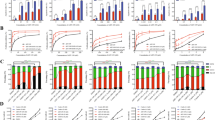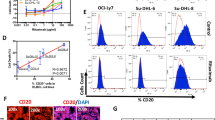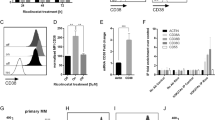Abstract
Gemtuzumab ozogamicin (GO) is a calicheamicin-conjugated antibody directed against CD33, an antigen highly expressed on acute myeloid leukemic (AML) cells. CD33-specific binding triggers internalization of GO and subsequent hydrolytic release of calicheamicin. Calicheamicin then translocates to the nucleus, intercalates in the DNA structure and subsequently induces double-strand DNA breaks. GO is part of clinical practice for AML, but is frequently associated with severe side effects. Therefore, combination of GO with other therapeutics is warranted to reduce toxicity, while maximizing therapeutic selectivity. We hypothesized that the histone deacetylase inhibitor valproic acid (VPA) sensitizes AML cells to GO. VPA-induced histone hyperacetylation opens the chromatin structure, whereby the DNA intercalation of calicheamicin should be augmented. We found that clinically relevant concentrations of VPA potently augmented the tumoricidal activity of GO towards AML cell lines and primary AML blasts. Moreover, VPA treatment indeed augmented the DNA intercalation of calicheamicin and enhanced DNA degradation. Importantly, synergy was restricted to CD33-positive AML cells and did not require caspase activation. In conclusion, the synergistic proapoptotic activity of cotreatment of AML cells with VPA and GO indicates the potential value of this strategy for AML.
This is a preview of subscription content, access via your institution
Access options
Subscribe to this journal
Receive 12 print issues and online access
$259.00 per year
only $21.58 per issue
Buy this article
- Purchase on Springer Link
- Instant access to full article PDF
Prices may be subject to local taxes which are calculated during checkout


Similar content being viewed by others
References
van der Velden VH, te Marvelde JG, Hoogeveen PG, Bernstein ID, Houtsmuller AB, Berger MS et al. Targeting of the CD33-calicheamicin immunoconjugate Mylotarg (CMA-676) in acute myeloid leukemia: in vivo and in vitro saturation and internalization by leukemic and normal myeloid cells. Blood 2001; 97: 3197–3204.
Dinndorf PA, Andrews RG, Benjamin D, Ridgway D, Wolff L, Bernstein ID . Expression of normal myeloid-associated antigens by acute leukemia cells. Blood 1986; 67: 1048–1053.
Amico D, Barbui AM, Erba E, Rambaldi A, Introna M, Golay J . Differential response of human acute myeloid leukemia cells to gemtuzumab ozogamicin in vitro: role of Chk1 and Chk2 phosphorylation and caspase 3. Blood 2003; 101: 4589–4597.
Schwemmlein M, Peipp M, Barbin K, Saul D, Stockmeyer B, Repp R et al. A CD33-specific single-chain immunotoxin mediates potent apoptosis of cultured human myeloid leukaemia cells. Br J Haematol 2006; 133: 141–151.
Sperr WR, Florian S, Hauswirth AW, Valent P . CD 33 as a target of therapy in acute myeloid leukemia: current status and future perspectives. Leuk Lymphoma 2005; 46: 1115–1120.
Zein N, Poncin M, Nilakantan R, Ellestad GA . Calicheamicin gamma 1I and DNA: molecular recognition process responsible for site-specificity. Science 1989; 244: 697–699.
Bross PF, Beitz J, Chen G, Chen XH, Duffy E, Kieffer L et al. Approval summary: gemtuzumab ozogamicin in relapsed acute myeloid leukemia. Clin Cancer Res 2001; 7: 1490–1496.
Larson RA, Sievers EL, Stadtmauer EA, Lowenberg B, Estey EH, Dombret H et al. Final report of the efficacy and safety of gemtuzumab ozogamicin (Mylotarg) in patients with CD33-positive acute myeloid leukemia in first recurrence. Cancer 2005; 104: 1442–1452.
Giles FJ, Kantarjian HM, Kornblau SM, Thomas DA, Garcia-Manero G, Waddelow TA et al. Mylotarg (gemtuzumab ozogamicin) therapy is associated with hepatic venoocclusive disease in patients who have not received stem cell transplantation. Cancer 2001; 92: 406–413.
Sievers EL, Larson RA, Stadtmauer EA, Estey E, Lowenberg B, Dombret H et al. Efficacy and safety of gemtuzumab ozogamicin in patients with CD33-positive acute myeloid leukemia in first relapse. J Clin Oncol 2001; 19: 3244–3254.
Kuendgen A, Knipp S, Fox F, Strupp C, Hildebrandt B, Steidl C et al. Results of a phase 2 study of valproic acid alone or in combination with all-trans retinoic acid in 75 patients with myelodysplastic syndrome and relapsed or refractory acute myeloid leukemia. Ann Hematol 2005; 84 (Suppl 13): 61–66.
Johannessen CU . Mechanisms of action of valproate: a commentatory. Neurochem Int 2000; 37: 103–110.
Gottlicher M, Minucci S, Zhu P, Kramer OH, Schimpf A, Giavara S et al. Valproic acid defines a novel class of HDAC inhibitors inducing differentiation of transformed cells. EMBO J 2001; 20: 6969–6978.
Cinatl Jr J, Cinatl J, Scholz M, Driever PH, Henrich D, Kabickova H et al. Antitumor activity of sodium valproate in cultures of human neuroblastoma cells. Anticancer Drugs 1996; 7: 766–773.
Marchion DC, Bicaku E, Daud AI, Sullivan DM, Munster PN . Valproic acid alters chromatin structure by regulation of chromatin modulation proteins. Cancer Res 2005; 65: 3815–3822.
Facchetti F, Previdi S, Ballarini M, Minucci S, Perego P, La Porta CA . Modulation of pro- and anti-apoptotic factors in human melanoma cells exposed to histone deacetylase inhibitors. Apoptosis 2004; 9: 573–582.
Sundstrom C, Nilsson K . Establishment and characterization of a human histiocytic lymphoma cell line (U-937). Int J Cancer 1976; 17: 565–577.
Bremer E, Kuijlen J, Samplonius D, Walczak H, de Leij L, Helfrich W . Target cell-restricted and -enhanced apoptosis induction by a scFv:sTRAIL fusion protein with specificity for the pancarcinoma-associated antigen EGP2. Int J Cancer 2004; 109: 281–290.
Dowell JA, Korth-Bradley J, Liu H, King SP, Berger MS . Pharmacokinetics of gemtuzumab ozogamicin, an antibody-targeted chemotherapy agent for the treatment of patients with acute myeloid leukemia in first relapse. J Clin Pharmacol 2001; 41: 1206–1214.
Kell WJ, Burnett AK, Chopra R, Yin JA, Clark RE, Rohatiner A et al. A feasibility study of simultaneous administration of gemtuzumab ozogamicin with intensive chemotherapy in induction and consolidation in younger patients with acute myeloid leukemia. Blood 2003; 102: 4277–4283.
Schimmer AD, Pedersen IM, Kitada S, Eksioglu-Demiralp E, Minden MD, Pinto R et al. Functional blocks in caspase activation pathways are common in leukemia and predict patient response to induction chemotherapy. Cancer Res 2003; 63: 1242–1248.
Acknowledgements
We thank Arjan A van de Loosdrecht, Martine ED Chamuleau, Geert Mesander and Jelleke Dokter-Fokkens. Supported by grants from the Dutch Cancer Society (RUG 2002-2668 and 2005-3358) to WH.
Author information
Authors and Affiliations
Corresponding author
Rights and permissions
About this article
Cite this article
ten Cate, B., Samplonius, D., Bijma, T. et al. The histone deacetylase inhibitor valproic acid potently augments gemtuzumab ozogamicin-induced apoptosis in acute myeloid leukemic cells. Leukemia 21, 248–252 (2007). https://doi.org/10.1038/sj.leu.2404477
Received:
Revised:
Accepted:
Published:
Issue Date:
DOI: https://doi.org/10.1038/sj.leu.2404477
Keywords
This article is cited by
-
Pretreatment of leukemic cells with low-dose decitabine markedly enhances the cytotoxicity of gemtuzumab ozogamicin
Leukemia (2013)
-
Efficacy and resistance of gemtuzumab ozogamicin for acute myeloid leukemia
International Journal of Hematology (2013)
-
The novel calicheamicin-conjugated CD22 antibody inotuzumab ozogamicin (CMC-544) effectively kills primary pediatric acute lymphoblastic leukemia cells
Leukemia (2012)
-
Resveratrol increases rate of apoptosis caused by purine analogues in malignant lymphocytes of chronic lymphocytic leukemia
Annals of Hematology (2011)
-
Simvastatin and purine analogs have a synergic effect on apoptosis of chronic lymphocytic leukemia cells
Annals of Hematology (2010)



